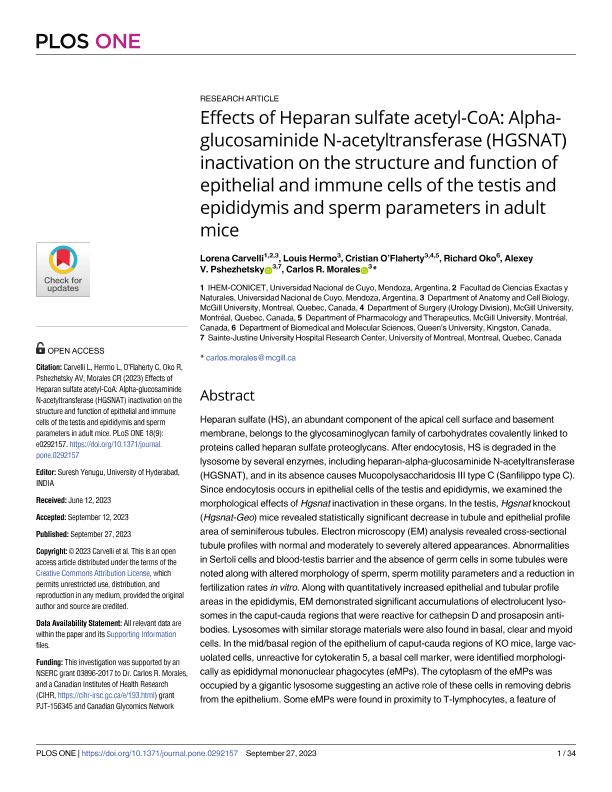Mostrar el registro sencillo del ítem
dc.contributor.author
Carvelli, Flavia Lorena

dc.contributor.author
Hermo, Louis
dc.contributor.author
O’Flaherty, Cristian
dc.contributor.author
Oko, Richard
dc.contributor.author
Pshezhetsky, Alexey V.
dc.contributor.author
Morales, Carlos R.
dc.date.available
2024-03-13T14:33:57Z
dc.date.issued
2023-09
dc.identifier.citation
Carvelli, Flavia Lorena; Hermo, Louis; O’Flaherty, Cristian; Oko, Richard; Pshezhetsky, Alexey V.; et al.; Effects of Heparan sulfate acetyl-CoA: Alpha-glucosaminide N-acetyltransferase (HGSNAT) inactivation on the structure and function of epithelial and immune cells of the testis and epididymis and sperm parameters in adult mice; Public Library of Science; Plos One; 18; 9-2023; 1-34
dc.identifier.issn
1932-6203
dc.identifier.uri
http://hdl.handle.net/11336/230405
dc.description.abstract
Heparan sulfate (HS), an abundant component of the apical cell surface and basement membrane, belongs to the glycosaminoglycan family of carbohydrates covalently linked to proteins called heparan sulfate proteoglycans. After endocytosis, HS is degraded in the lysosome by several enzymes, including heparan-alpha-glucosaminide N-acetyltransferase (HGSNAT), and in its absence causes Mucopolysaccharidosis III type C (Sanfilippo type C). Since endocytosis occurs in epithelial cells of the testis and epididymis, we examined the morphological effects of Hgsnat inactivation in these organs. In the testis, Hgsnat knockout (Hgsnat-Geo) mice revealed statistically significant decrease in tubule and epithelial profile area of seminiferous tubules. Electron microscopy (EM) analysis revealed cross-sectional tubule profiles with normal and moderately to severely altered appearances. Abnormalities in Sertoli cells and blood-testis barrier and the absence of germ cells in some tubules were noted along with altered morphology of sperm, sperm motility parameters and a reduction in fertilization rates in vitro. Along with quantitatively increased epithelial and tubular profile areas in the epididymis, EM demonstrated significant accumulations of electrolucent lysosomes in the caput-cauda regions that were reactive for cathepsin D and prosaposin antibodies. Lysosomes with similar storage materials were also found in basal, clear and myoid cells. In the mid/basal region of the epithelium of caput-cauda regions of KO mice, large vacuolated cells, unreactive for cytokeratin 5, a basal cell marker, were identified morphologically as epididymal mononuclear phagocytes (eMPs). The cytoplasm of the eMPs was occupied by a gigantic lysosome suggesting an active role of these cells in removing debris from the epithelium. Some eMPs were found in proximity to T-lymphocytes, a feature of dendritic cells. Taken together, our results reveal that upon Hgsnat inactivation, morphological alterations occur to the testis affecting sperm morphology and motility parameters and abnormal lysosomes in epididymal epithelial cells, indicative of a lysosomal storage disease.
dc.format
application/pdf
dc.language.iso
eng
dc.publisher
Public Library of Science

dc.rights
info:eu-repo/semantics/openAccess
dc.rights.uri
https://creativecommons.org/licenses/by-nc-sa/2.5/ar/
dc.subject
HGSNAT
dc.subject
EPIDIDYMIS
dc.subject
SPERM
dc.subject
MUCOPOLYSACCHARIDOSIS
dc.subject.classification
Biología Reproductiva

dc.subject.classification
Ciencias Biológicas

dc.subject.classification
CIENCIAS NATURALES Y EXACTAS

dc.title
Effects of Heparan sulfate acetyl-CoA: Alpha-glucosaminide N-acetyltransferase (HGSNAT) inactivation on the structure and function of epithelial and immune cells of the testis and epididymis and sperm parameters in adult mice
dc.type
info:eu-repo/semantics/article
dc.type
info:ar-repo/semantics/artículo
dc.type
info:eu-repo/semantics/publishedVersion
dc.date.updated
2024-03-13T14:24:10Z
dc.journal.volume
18
dc.journal.pagination
1-34
dc.journal.pais
Estados Unidos

dc.journal.ciudad
San Francisco
dc.description.fil
Fil: Carvelli, Flavia Lorena. McGill University; Canadá. Universidad Nacional de Cuyo. Facultad de Ciencias Exactas y Naturales; Argentina. Consejo Nacional de Investigaciones Científicas y Técnicas. Centro Científico Tecnológico Conicet - Mendoza. Instituto de Histología y Embriología de Mendoza Dr. Mario H. Burgos. Universidad Nacional de Cuyo. Facultad de Ciencias Médicas. Instituto de Histología y Embriología de Mendoza Dr. Mario H. Burgos; Argentina
dc.description.fil
Fil: Hermo, Louis. McGill University; Canadá
dc.description.fil
Fil: O’Flaherty, Cristian. McGill University; Canadá
dc.description.fil
Fil: Oko, Richard. Queens University; Canadá
dc.description.fil
Fil: Pshezhetsky, Alexey V.. McGill University; Canadá
dc.description.fil
Fil: Morales, Carlos R.. McGill University; Canadá
dc.journal.title
Plos One

dc.relation.alternativeid
info:eu-repo/semantics/altIdentifier/url/https://journals.plos.org/plosone/article?id=10.1371/journal.pone.0292157
dc.relation.alternativeid
info:eu-repo/semantics/altIdentifier/doi/http://dx.doi.org/10.1371/journal.pone.0292157
Archivos asociados
